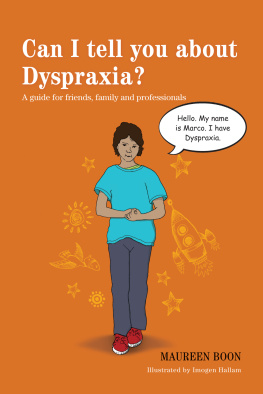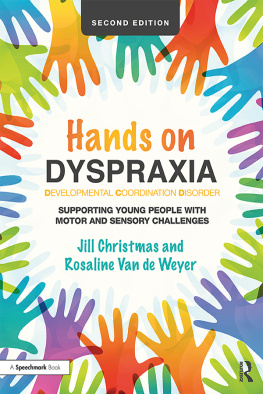Kathy Hoopmann - All about Dyspraxia: Understanding Developmental Coordination Disorder
Here you can read online Kathy Hoopmann - All about Dyspraxia: Understanding Developmental Coordination Disorder full text of the book (entire story) in english for free. Download pdf and epub, get meaning, cover and reviews about this ebook. year: 2022, publisher: Jessica Kingsley Publishers, genre: Home and family. Description of the work, (preface) as well as reviews are available. Best literature library LitArk.com created for fans of good reading and offers a wide selection of genres:
Romance novel
Science fiction
Adventure
Detective
Science
History
Home and family
Prose
Art
Politics
Computer
Non-fiction
Religion
Business
Children
Humor
Choose a favorite category and find really read worthwhile books. Enjoy immersion in the world of imagination, feel the emotions of the characters or learn something new for yourself, make an fascinating discovery.
- Book:All about Dyspraxia: Understanding Developmental Coordination Disorder
- Author:
- Publisher:Jessica Kingsley Publishers
- Genre:
- Year:2022
- Rating:4 / 5
- Favourites:Add to favourites
- Your mark:
All about Dyspraxia: Understanding Developmental Coordination Disorder: summary, description and annotation
We offer to read an annotation, description, summary or preface (depends on what the author of the book "All about Dyspraxia: Understanding Developmental Coordination Disorder" wrote himself). If you haven't found the necessary information about the book — write in the comments, we will try to find it.
Kathy Hoopmann: author's other books
Who wrote All about Dyspraxia: Understanding Developmental Coordination Disorder? Find out the surname, the name of the author of the book and a list of all author's works by series.














 ALL ABOUT DYSPRAXIA Understanding Developmental Coordination Disorder KATHY HOOPMANN
ALL ABOUT DYSPRAXIA Understanding Developmental Coordination Disorder KATHY HOOPMANN  This book is dedicated to the dyspraxic community worldwide.
This book is dedicated to the dyspraxic community worldwide. Some people think dyspraxia is all about
Some people think dyspraxia is all about Those with dyspraxia have brains that are wired differently
Those with dyspraxia have brains that are wired differently The messages from their brains to their bodies are mixed up
The messages from their brains to their bodies are mixed up They can trip over anything, even things that arent there, and
They can trip over anything, even things that arent there, and Getting dressed can be tricky,
Getting dressed can be tricky,  and buttons and shoelaces are hard to master.
and buttons and shoelaces are hard to master.  They often topple, spill or break things,
They often topple, spill or break things,  even though they try to be careful.
even though they try to be careful.  They are not sure what strength to apply so may
They are not sure what strength to apply so may Their skills might be uneven.
Their skills might be uneven.  Learning to balance or ride can take a long time,
Learning to balance or ride can take a long time,  and sports can be challenging.
and sports can be challenging.  They can become good at avoiding activities
They can become good at avoiding activities and need understanding and
and need understanding and When activities are broken down into smaller parts, and they
When activities are broken down into smaller parts, and they It helps when they are shown what to do.
It helps when they are shown what to do.  Mixed messages from the brain can also cause low muscle tone so those with dyspraxia may do tasks more slowly than others.
Mixed messages from the brain can also cause low muscle tone so those with dyspraxia may do tasks more slowly than others.  Some have extra flexible joints that are easily
Some have extra flexible joints that are easily Even sitting uses loads of muscles, so they cant do that for long!
Even sitting uses loads of muscles, so they cant do that for long!  Besides, they listen better when they move.
Besides, they listen better when they move.  Reading may be tiring as its not easy to track each line.
Reading may be tiring as its not easy to track each line.  Letters may blend together until one word blurs with the next.
Letters may blend together until one word blurs with the next.  Copying from a board can be tough,
Copying from a board can be tough,  and often their writing is messy and difficult to read.
and often their writing is messy and difficult to read. 